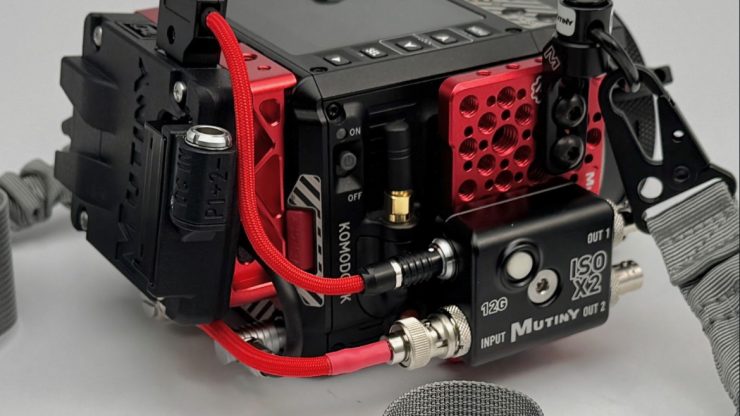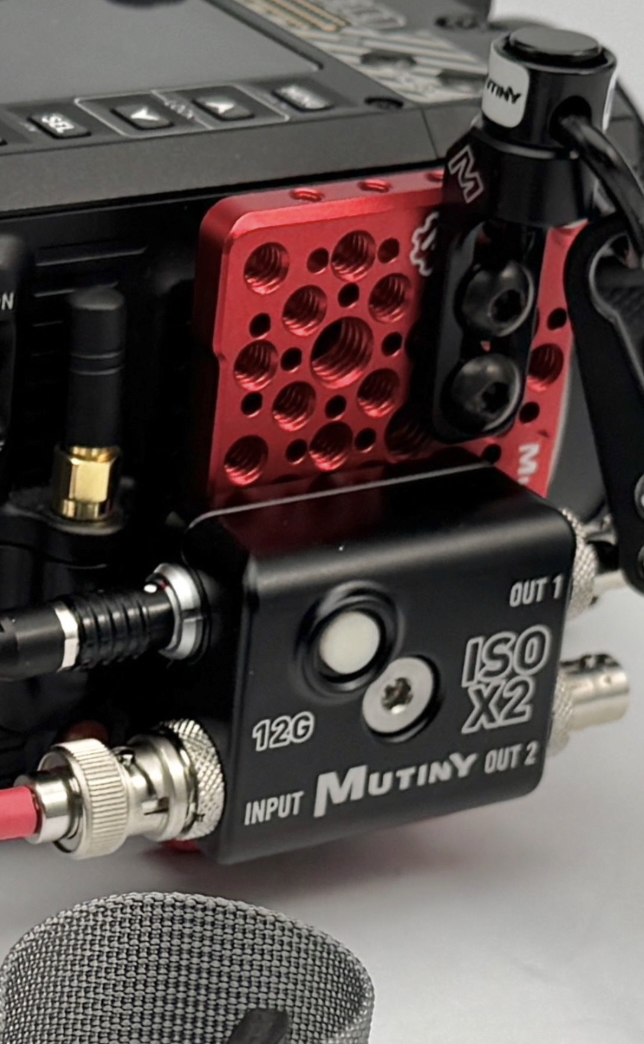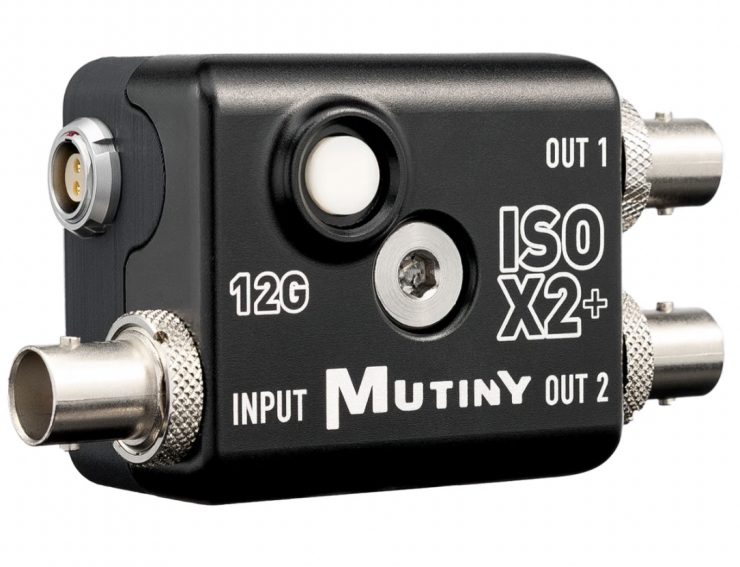
Mutiny has opened up pre-orders for their upcoming ISO X2 12G SDI 1:2 re-clocking video distribution amp with isolator built in. In addition, they will also be launching the ISO X2+, which offers 2-pin power distribution to power a wireless video TX and a monitor.

Both these products were built in conjunction with the 12G SDI experts at Freakshow, using their best-in-class technology that has been proven over the years on the sets of major television shows and feature productions.

12G isolators were designed to help protect your 12G port on your camera, monitor, or other 12G SDI device.
Instead of removing the 12G SDI cable from the camera when powering up/down the camera and between battery swaps, you simply switch from the signal (SIG) to isolation (ISO) mode. Once switched to ISO, the red LED turns off, and your signal feed to your monitor/wireless TX is cut while maintaining ground at all times. You then swap your battery with a fresh one. Once everything is on, you switch back to signal (SIG) the red LED turns on, and your video feed is now live again. The isolator does require power via a 2pin 0B input. Once the isolator is in ISO mode, it retains isolation when power is removed between battery swaps.
Unlike other solutions on the market, our 12G isolator features two levels of protection. The first level of protection is an ESD smart circuit that is AC coupled preventing any DC present on the signal. The second level of protection is a logic switch which is a button with electronic switching, that when engaged, cuts the signal path to the camera and to the monitor / wireless transmitter electronically, keeping only ground connected at all times. This arrests any power spikes from going back to the camera’s sensitive 12G SDI port via the signal wire which is the center pin of the SDI cable.
Mutiny also recommends Safetap V4 power cables versus standard D/P-tap cables. Savfetap V4 cables electronically connect ground before positive, making for an even higher level of safety for all your devices.
12G SDI cameras that can be protected with our isolator: BLACKMAGIC (PYXIS, URSA MINI PRO, etc), RED (KOMODO / KOMODO-X / V-RAPTOR S35/VV/XL), Sony (Venice / Venice 2 / FX6 / FX9 / FR7, ARRI (Alexa 35), Canon (C300 MKIII/C500 MKII), and more for up to 4K 1000fps at 23.98-30hz output.
HOW TO USE:
The TRUE 12G Isolator acts similarly to the SDI cable process, but instead of unplugging your cable before setup, battery swap,s and shut-down, you use the isolator switch instead. Even if your battery dies, you can still switch to ISO after the fact (before removing the battery) and still be protected.
- When first setting up your camera, plug in the isolator to your power source and switch it to ISO mode.
- Turn on your camera and plug in your SDI cable.
- Slide the isolator switch to SIG (signal) mode and you will see the video feed on your monitor.
- When your battery gets low or you are done shooting, slide the isolator switch to ISO mode.
- Remove the input SDI and unplug the isolator power as the last step.
- If your battery accidentally dies before you had a chance to flip the switch to ISO mode, simply switch to ISO mode before removing your battery or disconnecting the isolator power cable.
SPECS:
Mounting 1/4-20 captive screw with removable, re-orientable Arri locating pin and includes a 3/8-16 adapter.
- Formats
- 4K 12G-SDI, Ultra 4K 6G-SDI, 3G-SDI, 1.5G-SDI, 270Mb-SDI.
- Meets and exceeds SMPTE-424, SMPTE-292, SMPTE-259
- Inputs
- 1x12G/ 6G/ 3G/ 1.5G/ 270Mb
- Auto-selectable SDI
- 1xBNC
- Power 5-35v input. Output equals what is input and has a 5A limit
- Outputs
- (same as above, but with proper number of outputs for each device), equalization and re-clocking
- Cable Re-clocking and Equalization
- (all with Belden 1694A – divide by half for Belden 1505): 75 meters (246ft) at 12G, 100 meters (328ft) at 6G, 220 meters (722ft) at 3G, 265 meters (870ft) at HD, 530 meters (1740ft) at SD
- Input Return Loss
- -8dB at 12G, -9dB at 6G, -13dB at 3G, -18dB HD/SD
- Output Return Loss
- -6dB at 12G, -8.5dB at 6G, -15dB at 3G, -23dB at HD/SDI
Why is this an issue? Well, I am glad you asked. SDI input and output failures can happen to all types of video gear, cameras, recorders, and monitors. Some failures are caused by ESD (electrostatic discharge). This can happen when power and SDI cables are attached in the wrong order, or when connecting long cables (greater than 10 meters / 30 feet).
Under certain conditions, the SDI outputs of cameras can be damaged by a power surge. So, how do you avoid this from happening? Well, the best practice is to connect the power and BNC cables in a particular order and to also use shielded power cables and high-quality undamaged BNC cables. If you really don’t want to be that person who is screaming because their SDI port just got fried, then be careful what SDI cables you buy. Buying a generic brand on Amazon might save you a few bucks, but if you are using expensive digital cinema cameras or other equipment, is it really worth the risk?
SDI outputs on cameras can get damaged when an accessory is connected to the SDI output and is powered through an unshielded cable. All cameras and other SDI devices, no matter who makes them, can be affected by this. This problem is even more prevalent with cameras that feature SDI connections capable of SDI 6G or higher. It doesn’t matter even if you only ever use them at lower bit rates like SDI 1.5G.
So why does the damage occur? Damage to an SDI connection can occur when connecting an unshielded power cable to an accessory that is already connected to the SDI output of the camera. If the plus pin is contacted before the negative pin, the BNC cable will close the current circuit, resulting in fatal damage to the included SDI driver chip because it is not designed to handle such high currents. Conversely, this problem can also occur when disconnecting an unshielded power cable of an accessory that is still connected to the SDI output of the camera. Again, and I can’t stress this enough, don’t use damaged or low-quality BNC cables because you are playing with fire.
The best habit to get into is to practice the following:
- When you are setting up your equipment, ALWAYS connect the power cable to your accessory first and then the SDI cable before powering on the camera
- Once you have finished using your equipment, ALWAYS remove the SDI cable first and then the power cable
- If you want to go a step further with protection, you can also buy an SDI Isolator Cable, however, the caveat with any SDI isolator is that it can reduce signal quality as well as restrict the maximum length of the cable you can use.
Pricing & Availability
The Mutiny ISO X2 and ISO X2+ and now available to pre-order for $450 USD and $500 USD, respectively.
PRE-ORDER NOTE: ISO X2 and ISO X2+ both ship approximately the last week of MAY





